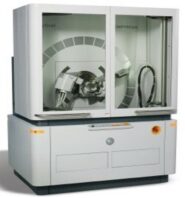X-RAY DIFFRACTION (XRD)
X-ray Diffraction (XRD) is used to identify and quantify the different phases of crystalline materials, whether they are massive, in powder form or in thin films.
The graph resulting from X-ray diffraction by the atoms or molecules constituting a material is called diffractogram. It is presented as a series of peaks associated with specific angles of diffraction. The position of these peaks is directly related, by Bragg's law, to the arrangement of the atoms (distances between atoms and between the crystal planes).
A fine analysis of the diffractogram (width and shape of the peaks), in particular by the Rietveld method, is used to determine the size and the shape of the crystallites as well as the constraints and the possible deformations of the crystal lattice.
In a mixture, XRD is used to determine the various crystalline phases present. It is also possible to highlight the presence of an amorphous (non-crystallized) part.
Our equipment can be configured to work under grazing incidence in order to make analyses on thin films and to carry out reflectometry measurements (determination of the thickness of thin layers).
- Generator: 3.3 kW
- X-ray tube with Cu anode
- Automatic inlet and outlet slit system for analysis of a defined area
- 15-sample autosampler (conventional Bragg Brentano mode)
- Proportional detector and PIXcel 1D detector
- 0.026° resolution
- Input optics for convergent or parallel beam
Characteristics :
- Identification and quantification of crystalline phases
- Analysis of massive materials, powders and thin films (grazing incidence)
- Size of crystallites
- Constraints / lattice deformation
- X-ray reflectometry
